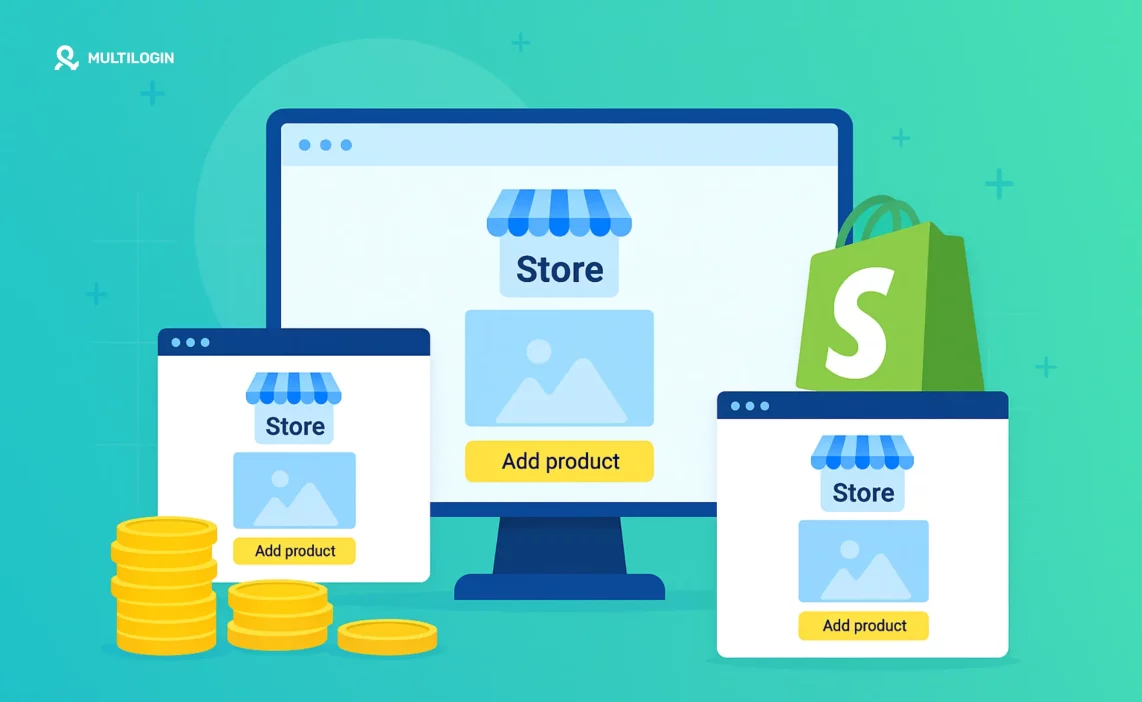Here’s the thing nobody tells you about scaling on Shopify: your second store is where things get interesting—and complicated.
It happens all the time. Merchants launch their first Shopify store, sales start rolling in, and suddenly they’re thinking: “What if there was another store for that other product line?” or “What if targeting a different country with a separate store would work better?”
Great idea. But here’s the catch: managing multiple Shopify stores from the same computer can trigger security flags, payment holds, and account restrictions if done incorrectly.
The good news? It’s totally doable—and this guide shows exactly how to do it right.
Can I Create Multiple Stores on Shopify?
Yes, Shopify allows up to 10 stores under one account. Each store operates independently with its own domain, products, and settings. But (and this is important), each store requires its own paid subscription—no bulk discounts, unfortunately.
Think of it like this: Shopify lets merchants build an empire, but rent is due on each property.
Why Would Anyone Want Multiple Shopify Stores?
Before spinning up stores left and right, let’s talk about when it actually makes sense:
Targeting Different Markets
Running a US store and want to expand to Europe? A separate store handles different currencies, languages, and shipping rules without confusing American customers. Brands often double their revenue by creating region-specific stores that feel local.
Separating Brands
Selling premium leather bags AND budget phone cases? Those are different audiences with different expectations. Two stores mean two distinct brand identities—no confusion, no diluted messaging.
Testing New Products
Want to test a risky product line without jeopardizing the main store’s reputation? A separate test store serves as a sandbox. If it flops, the main brand stays clean.
Wholesale vs. Retail
B2B customers expect bulk pricing and different checkout experiences. A dedicated wholesale store keeps retail customers from seeing trade prices (and getting confused).
How Many Stores Can I Make with Shopify?
Maximum: 10 stores per Shopify account. Merchants can switch between them from the admin dashboard—click the store name in the top left, select “All stores,” and manage the entire empire from there.
But here’s the reality check: most merchants struggle to manage more than 3-4 stores effectively. More stores mean more inventory headaches, more customer service channels, and more opportunities for things to go wrong.
Starting with one or two and scaling when systems are in place is the smart approach.
How Much Does It Cost to Have Multiple Shopify Stores?
This is where it gets expensive. Each store needs its own subscription:
- Basic Plan: $39/month per store
- Shopify Plan: $105/month per store
- Advanced Plan: $399/month per store
- Shopify Plus: Starting at $2,000/month (but with better multi-store features)
Running 5 Basic stores? That’s $195/month just in subscription fees. Add apps, themes, and transaction fees, and costs multiply fast.
What About Shopify Plus Multiple Stores?
For serious volume, Shopify Plus changes the game. Merchants get up to 9 additional stores (10 total) with better tools for managing them:
- Centralized admin for all stores
- Shared inventory across locations
- Bulk product syncing
- Advanced automation
- Dedicated support
Plus customers typically run international stores, multiple brands, or wholesale operations. For businesses doing $500K+ annually, it’s worth the investment.
How Much Does Shopify Take from a $100 Sale?
Quick math because this affects multi-store budgets:
With Shopify Payments (no transaction fees):
- Basic: 2.9% + 30¢ = $3.20 per $100 sale
- Shopify: 2.7% + 30¢ = $3.00 per $100 sale
- Advanced: 2.5% + 30¢ = $2.80 per $100 sale
Without Shopify Payments (using PayPal, Stripe, etc.):
- Add 0.5-2% transaction fee on top of payment processor fees
Multiply this across multiple stores and the fees add up. This is why choosing the right plan matters.
How to Create Multiple Shopify Stores (Step-by-Step)
Alright, let’s get tactical. Here’s how to actually set up a second (or third, or fourth) store:
Step 1: Log Into Your Shopify Account
Go to the existing store’s admin. Click the store name in the top left corner, then select “All stores.”
Step 2: Click “Create Store”
There’s a big button that says “Create store.” Click it. Shopify will ask for:
- Store name (choose wisely—this affects the myshopify.com URL)
- Store purpose (online store, retail, etc.)
- Business details (address, industry, etc.)
Step 3: Choose Your Plan
Each store needs its own subscription. Starting with Basic for testing and upgrading later when revenue justifies it makes sense.
Pro tip: Using a different credit card for each store helps with accounting and reduces the risk of all stores being affected if one payment fails.
Step 4: Set Up Your Domain
Each store needs its own domain. Options include:
- Buy a new domain through Shopify ($14-17/year)
- Connect an existing owned domain
- Use a subdomain (like uk.yourbrand.com)
SEO tip: Separate domains (yourbrand.co.uk) rank better than subdomains for international SEO.
Step 5: Configure Store Settings
This is where things get important. For each store, set up:
- Payments: Different stores can use different payment processors
- Shipping: Create zone-specific rates
- Taxes: Configure for the target market
- Currency: Match the target audience
Step 6: Design and Launch
Choose a theme, add products, and go live. Simple, right?
Can You Have Multiple Shopify Stores Under One Email?
Yes. All 10 stores can be managed with the same email address. Shopify’s “All stores” feature lets merchants switch between them seamlessly.
But here’s a better approach: use separate emails for different store types. For stores serving different brands or clients, separate emails help with organization and security.
For example:
- Personal brand: [email protected]
- Client stores: [email protected], [email protected]
How Many Stores Can You Have on Shopify Basic Plan?
Still 10 stores maximum, even on the Basic plan. The plan level doesn’t change the store limit—it just affects features and fees per store.
But realistically, merchants running multiple stores on Basic plans are probably outgrowing Basic. The $39/month plan is great for testing, but serious multi-store operators usually need the Shopify or Advanced plan for better reporting and lower fees.
Can You Make Multiple Shopify Stores on One Account?
Yes—this is literally what this guide covers. One Shopify account = up to 10 stores.
The confusion comes from “account” vs. “store.” An account is the login. Stores are the individual shops created under that account.
Think of it like Netflix: one account, multiple profiles.
Shopify Multiple Stores One Domain—Is It Possible?
No. Each Shopify store requires its own unique domain. Two stores can’t run on the same domain.
However, merchants can use:
- Different domains: brand1.com and brand2.com
- Subdomains: us.brand.com and uk.brand.com
- Country-specific domains: brand.com and brand.co.uk
Subdomains are technically “one domain” but they’re treated as separate URLs by Shopify and search engines.
Shopify Multiple Stores Same Inventory—How Does It Work?
Shopify doesn’t natively sync inventory across stores. This is one of the biggest pain points for multi-store merchants.
Available options:
1. Manual Management (not recommended)
Update inventory in each store separately. This works for 2 stores with low volume, but it’s a nightmare at scale.
2. Third-Party Apps
Apps like Syncio, Trunk, or Ablestar can sync inventory across stores. They cost $20-100/month but save hours of manual work.
3. Shopify Plus Multi-Location Inventory
Plus merchants can set up shared inventory pools across stores. This is the cleanest solution but requires the Plus plan.
4. Separate Inventory
Some merchants just maintain separate inventory for each store. Works if selling different products or having multiple warehouses.
The Hidden Risk of Managing Multiple Shopify Stores
Here’s what most guides won’t tell you: Shopify’s fraud detection algorithms monitor for suspicious multi-store activity.
When logging into multiple stores from the same browser, using the same payment methods, or showing other “linked account” patterns, Shopify’s algorithms might flag the activity for review. This can lead to:
- Payment holds
- Account verification requests
- Delayed payouts
- Store suspensions (in extreme cases)
This is especially risky when:
- Running stores in different countries
- Managing client stores as an agency
- Operating competing brands
- Testing different business models
The solution? Proper account isolation is needed.
How Multilogin Solves the Multi-Store Security Problem
This is where Multilogin’s antidetect browser becomes essential for professional multi-store management.
Here’s the problem: when managing multiple Shopify stores from the same computer, Shopify can detect:
- Browser fingerprint (unique device ID)
- IP address
- Cookies and session data
- Login patterns and behavior
Even using different browsers (Chrome for Store A, Firefox for Store B), Shopify’s systems can still link accounts through device fingerprinting.
Multilogin creates completely isolated browser profiles for each store. Each profile has:
- Unique browser fingerprint (Shopify sees a different device)
- Separate cookies and sessions (zero data leakage)
- Different IP addresses (when combined with proxies)
- Independent browsing history
For agencies managing 10+ client stores, this is non-negotiable. One client’s account issue won’t affect the others because Shopify sees them as completely separate users.
Pro tip: Combining Multilogin with residential proxies for each store makes each store appear to be accessed from a different location, which is especially important for international stores.
Best Practices for Managing Multiple Shopify Stores
1. Use Different Payment Methods
Separate credit cards for each store make accounting easier and reduce risk if one payment fails.
2. Maintain Separate Business Entities
For truly separate brands, consider separate LLCs or business entities. Better for taxes and liability protection.
3. Create Standard Operating Procedures
Document processes for each store: product uploads, customer service, inventory management. This makes delegation possible.
4. Use a Password Manager
Managing 10 different logins? Use 1Password or LastPass to keep credentials organized and secure.
5. Set Up Proper Analytics
Use Google Analytics with separate properties for each store. Track performance independently.
6. Don’t Cross-Promote Too Aggressively
If stores target different audiences, don’t spam customers with irrelevant cross-promotions. It damages trust.
7. Use Multilogin for Account Isolation
Especially when managing client stores or running stores in different countries. The security and organization benefits are worth it. Learn more about multi-account management and how antidetect browsers help with e-commerce.
👉 Don’t risk bans: Try Multilogin and keep your accounts undetected.
Frequently Asked Questions About Creating Multiple Shopify Stores
No. You need completely separate accounts with unique emails for each store. Shopify Plus offers multi-store for enterprises, but doesn’t provide the isolation needed for independent operations.
Yes—frequently. IP monitoring is primary fraud detection. Always run stores with unique residential proxies and fingerprint isolation.
Depends on your plan:
- Pro 10: Up to 10 stores (€5.85/month)
- Pro 50/100: Small agencies
- Business 300+: Enterprise operations
Yes—Multilogin’s team access and cloud storage let you share profiles securely without exposing credentials. Role-based permissions ensure team members only access assigned stores.
Normal for certain regions or after unusual activity. Respond promptly with accurate documentation matching store’s registered information. Never reuse identity documents across multiple stores claiming different businesses.
Conclusion
Running multiple Shopify stores can be highly profitable—enabling niche testing, market expansion, and risk isolation impossible with single stores. However, success depends entirely on keeping stores isolated from Shopify’s sophisticated detection systems.
The foundations:
- Technical isolation through Multilogin’s browser fingerprinting prevents account linking. Each store operates with unique canvas data, WebGL info, cookies—appearing as independent users to Shopify.
- IP separation through residential proxies eliminates the most obvious linking vector. Multilogin’s built-in proxies provide clean IPs assigned effortlessly.
- Operational discipline maintaining proper procedures ensures technical protection remains effective.
The alternative is unsustainable—constant restrictions, frozen payments, inability to scale, eventual permanent bans destroying your business.
Multilogin provides isolation (unique fingerprints, separate cookies, built-in proxies) and tools (pre-farmed cookies, API automation) to scale safely.
Investment vs. returns: Pro 10 starts at €5.85/month managing 10 isolated stores. Minimal cost compared to revenue potential—pays for itself preventing a single account restriction.
👉 Start your 3-day trial for €1.99 and create up to 5 stores safely with proxy traffic included.
👉 Or upgrade to Pro 10 (€5.85/month) to manage all your Shopify stores with confidence.
Grow your business, not your bans—with Multilogin.



